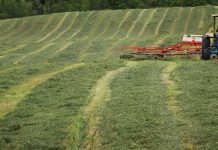Editor:
The Nov. 29 “Farm and Dairy” carried two articles dealing with the National Dairy Trust Fund proposal recently passed by the Senate ag committee and now pending approval on the Senate floor (Ed. note: the Senate was to continue farm bill debate Tuesday).
A brief, front-page article focused on opposition to the plan by both the National Milk Producers Federation and the Independent Dairy Foods Association. The article was short on analytical content and was apparently designed to convey the impression that all members of the dairy industry were opposed to the plan.
The article provoked more questions than answers. Why would an organization founded to represent the interests of dairy producers oppose the only piece of dairy legislation in the farm bill that could improve the financial situation for the majority of U.S. dairy farmers?
A later article by an OSU economist gave a more elaborate analysis of the apparent line of thinking, which can only be understood as “catch 22” logic. As I understand it, opposition is based on the following arguments and assumptions:
1) The costs of the proposal would eventually be born by the consumer, as processors would pass along any associated trust fund obligations. Retail costs of all dairy products would increase and consumption would decrease.
2) The idea of targeting benefits to small and mid-sized farmers would be regarded as too unfair and contrary to current trends. Large producers would circumvent the targeting mechanism by “reorganizing” their operations into smaller units to take advantage of the program benefits.
3) The idea of compensating dairy farmers when prices are low sends the wrong signals in the marketplace.
In response to the first argument, I would remind readers that:
* With regard to expected drops in consumer demand, milk is among the most inelastic of products. Consumers tend to buy the product regardless of significant pricing variances;
* Most Americans have indicated in surveys they would accept higher food prices if they are assured farmers are receiving the difference; and
* Processors and retailers of dairy products have maintained comfortable margins and, in fact, increased their proportion of the consumer’s food purchasing dollar over the last two decades while dairy farmers’ income has stagnated. The reality is that in many cases, processors and retailers could absorb much of the difference.
With regard to targeting:
* If a large producer wishes to legitimately reorganize his business into smaller units, more power to him. If he wants to construct a fraudulent or misrepresentative business structure in order to capitalize on the program, keep them out.
Large farmers already receive numerous benefits that are unavailable to small and mid-sized farmers, often including higher pay prices for their milk and access to more favorable markets. So let’s not talk about fairness in the marketplace.
* The proposed dairy trust fund incentive is unquestionably contrary to current production trends. It acknowledges that decentralization and diversity are healthy in any industry. I acknowledges that farm families and farm communities make a healthy contribution to our society and that it may make sense to adopt policies that are supportive of them.
Regarding the notion of sending the wrong signals in the marketplace:
* The notion of a well-functioning marketplace is very much an anachronism. It is a thing of the past.
* Dairy farm prices are set by the government as a function of the cheese sale prices on the Chicago Mercantile Exchange and they correlate perfectly when plotted on a graph. Retail prices, however, have a negative correlation to Exchange prices.
The conclusions are inescapable. There is a near zero correlation between the supply side of the equation (farm prices) and the demand side (retail prices). In this already-corrupt market, it is silly to be concerned about sending the wrong signals.
Give the idea of a National Dairy Trust Fund some real, unbiased consideration. Think about the positive contributions made by farm families and communities to the fabric of our nation. Think about the potential hazards of an overly concentrated livestock industry, about the vulnerability of weather, or excessive nutrient concentration, or even a targeted terrorist incident.
Each decision we make takes us closer to or further away from these possibilities. Let’s think about the course we are charting for our future.
Joe Logan
Kinsman
(The author is a member of the Ohio Farmers Union dairy committee.)












